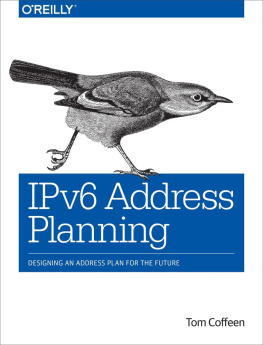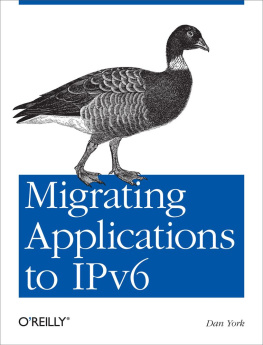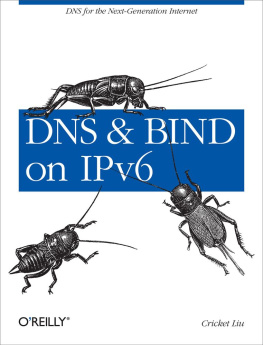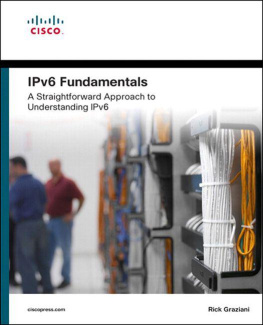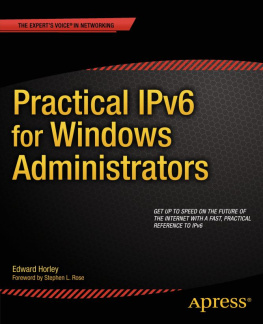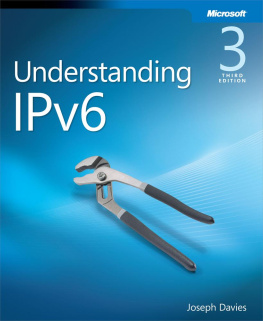IPv6 Address Planning
Tom Coffeen
Foreword
Cricket Liu
Chief Infrastructure Officer, Infoblox
If youve picked up this book and are reading the foreword, of all things, then Im going to assume you dont need to be persuaded that IPv6 is important. Vitally important, in fact. Downright critical.
In fact, its so important that even though youre already convinced, Im going to take a few sentences to try to really galvanize that conviction.
Most of the world is effectively out of IPv4 addresses. Of the five Regional Internet Registries that cover the worlds population, only one, AFRINIC, still has any substantial stock of IPv4 addresses. That means that the rest of the worlds population, about 85% of us, are going to have to get by without. And this couldnt have come at a worse time, when movements such as cloud computing, Bring Your Own Device, and the Internet of Things are consuming IP addresses faster and faster. Why, Asia alone is home to about 60% of the worlds population, or over four billion people, and Internet penetration there is estimated at only about 25%! That leaves three billion people without IP addresses and poor IPv4 only had 4.3 billion to start with.
Luckily, prescient Internet engineers knew this day was coming and designed a successor to your fathers version of the Internet Protocol. This protocol, IP version 6, replaces its predecessors 32-bit addresses with 128-bit IP addresses, for an address space that is about 8x1028 times bigger. A standard IPv6 subnet can contain more IP addresses than the entire IPv4 Internet squared!
What can you do with all that space? Lots of things. You can forget about trying to allocate subnets that are just big enough to accommodate the hosts on a LAN. You can devote groups of bits in the address to signify important attributes of your networks, like region, country, city, and department. You can design your address space so that it makes route summarization and access controls easier. Thats a lot to look forward to.
But you cant just apply the principles youve learned in IPv4 to designing your IPv6 address plan. IPv6s enormous address space is so large that it requires an entirely different way of thinking, dispensing with the practice of trying to allocate subnets just large enough to accommodate the expected population of hosts. But who can lead us out of IPv4s Valley of Despair, with its scarcity and guesstimating and gut-churning doubt? Well, I know a guy.
Tom Coffeen cut his teeth on Limelight Networks IPv6 rollout, and hes been talking about the protocol ever since, even when we begged him for a break. At Infoblox, hes advised dozens of our customers on IPv6 address planning. And hes whip-smart, a nonpareil wordsmith, and always ready with an amusing-but-relevant quote.
For all those reasons, I think youll really enjoy this.
Dedication
This book is dedicated to the memory of my father, Clifford Glenn Coffeen.
Preface
Its an exciting and somewhat daunting time to be a network engineer. Were living and working through an era of challenging but essential change in our chosen field. Think of the traditional protocols and operational practices that many of us cut our professional teeth on. Theyve helped deliver the Internet and sustained its initial period of unprecedented growth and success. But now theyre rapidly approaching the limits of their ability to enable the next critical stage of Internet and network evolution.
Virtualization, cloud computing, SDN, mobile devices, the Internet of Things all of these trends are laying bare the weaknesses of traditional networking technology. Such trends would seem to simultaneously promise and demand limitless network scale and unprecedented business agility, but from the same old tubes and wires and the quaint rules that bind them together. You can almost hear Scotty inveighing, She canna take anymore, Captain!
Unless youre Rip (or, perhaps, rIP ) Van Winkle, none of these weaknesses is as familiar as the limited and rapidly dwindling supply of IPv4 addresses. Likely just as familiar is the remedy for this shortage, IPv6.
Who Should Read This Book
Ive written this book with network architects, engineers and administrators for enterprises in mind. For practical examples, Ive tried to stick with scenarios and network designs that will be familiar to enterprise IT personnel. However, much of the material presented should be suitable to anyone who needs to learn about network address planning using IPv6. The addressing plan concepts well explore should be relevant and extensible to IP networks of any purpose or size.
The content of this book is based on the assumption that the reader has a working grasp of both the theory and practice of designing and operating computer networks. Universally deployed protocols like TCP/IP, and Ethernet and WAN and LAN architectures should already be very familiar to the reader, while a general knowledge of more recent trends in data-center virtualization, cloud computing, mobile networks, SDN, and the IoT may be helpful as we discuss how IPv6 addressing plan design is likely to be impacted by (and impact) these rapidly evolving technologies.
Ive aspired to make IPv6 Address Planning durably useful to network architects and engineers, whether they are:
- Getting started with IPv6 adoption
- Ramping up their IPv6 adoption efforts
- Iterating or improving their existing IPv6 addressing plans
- Adding IPv6 to an existing IPv4 network
- Designing and implementing a green-field IPv6 network
Whatever your particular situation, this book aims to help you design an addressing plan that will prove effective for years to come. To do that, youll need best-practice design concepts, principles, and practical examples. This book was conceived and written to help provide them.
Why I Wrote This Book
Begining in 2008, I was tasked with deploying IPv6 on a large service provider network. At the time, there was already a decent amount of technical literature on IPv6 at least enough to make a substantial, if not entirely confident, start. (And whatever might have been lacking in terms of documented architectural and operational practices, we at least knew wed need some IPv6 addresses!)
Since we had customers and infrastructure around the world, it made sense at the time to obtain IPv6 allocations from each of the Regional Internet Registries (RIRs). As a service provider, we were used to regularly requesting and obtaining IPv4 addresses, and it turned out to be remarkably easy to get three IPv6 allocations, one each from ARIN, APNIC, and RIPE (for North America, Asia Pacific, and Europe respectively).
Based on documentation we submitted, each RIR assigned us an allocation (still) fairly typical for a service provider request: one /32 of IPv6 address space (or 7.9x1028 addresses). Suddenly, after years of designing, deploying, and operating networks where every IPv4 subnet had to be carefully constrained to preserve a limited quantity of addresses for host assignment (along with the mostly futile attempt to preserve the ability to aggregate prefixes), I had the reverse problem on an astronomical scale: how the heck was I going to logically carve up a total of 3 times 7.9x1028 IPv6 addresses to number the network? What I needed was a comprehensive resource to walk me through how to design and manage an IPv6 addressing plan. But whatever task-specific information existed seemed to be scattered, very uncomprehensively, across many documents and sources.
This is, of course, not a particularly new kind of problem for any networking engineer. Arguably, its a perennial condition of our profession that hopefully keeps us challenged and engaged throughout our careers. Still, theres no point in struggling needlessly. The right book at the right time can go a long way toward maximizing our effectiveness and satisfaction as network engineers and architects. More bluntly, if a book can help you avoid dumb and costly mistakes or having to reinvent operational and architectural practice from scratch, thats probably a book worth reading and keeping handy.

